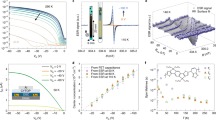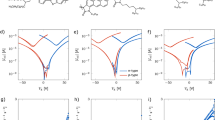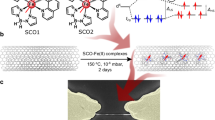Abstract
Carbon-based semiconductors such as conjugated organic polymers are of potential use in the development of spintronic devices and spin-based information processing. In particular, these materials offer a low spin–orbit coupling strength due to their relatively light constituent chemical elements, which should, in principle, favour long spin diffusion lengths. However, organic polymers are relatively disordered materials and typically have a carrier mobility that is orders of magnitude lower than crystalline inorganic materials. As a result, small spin diffusion lengths of around 50 nm have typically been measured using vertical organic spin valves. Here, we report measuring spin diffusion lengths in doped conjugated polymers using a lateral spin transport device architecture, which is based on spin pumping injection and inverse spin Hall detection. The approach suggests that long spin diffusion lengths of more than 1 μm and fast spin transit times of around 10 ns are possible in conjugated polymer systems when they have a sufficiently high spin density (around 1020 cm−3). We explain these results in terms of an exchange-based spin diffusion regime in which the exchange interactions decouple spin and charge transport.
This is a preview of subscription content, access via your institution
Access options
Access Nature and 54 other Nature Portfolio journals
Get Nature+, our best-value online-access subscription
$29.99 / 30 days
cancel any time
Subscribe to this journal
Receive 12 digital issues and online access to articles
$119.00 per year
only $9.92 per issue
Buy this article
- Purchase on Springer Link
- Instant access to full article PDF
Prices may be subject to local taxes which are calculated during checkout





Similar content being viewed by others
Data availability
The authors declare that all relevant data are included in the paper and in the accompanying Supplementary Information. Additional data are available from the corresponding authors upon reasonable request.
Change history
16 May 2019
Owing to a technical error, the ‘Published online’ date of this Article originally mistakenly appeared as ‘15 March 2019’, but should have been ‘18 March 2019’.
References
Cinchetti, M., Dediu, V. & Hueso, L. Activating the molecular spinterface. Nat. Mater. 16, 507–515 (2017).
Warner, M. et al. Potential for spin-based information processing in a thin-film molecular semiconductor. Nature 503, 504–508 (2013).
Dediu, V., Hueso, L., Bergenti, I. & Taliani, C. Spin routes in organic semiconductors. Nat. Mater. 8, 707–716 (2009).
Yu, Z. G. Spin–orbit coupling, spin relaxation, and spin diffusion in organic solids. Phys. Rev. Lett. 106, 106602 (2011).
Sinova, J., Valenzuela, S. O., Wunderlich, J., Back, C. H. & Jungwirth, T. Spin Hall effects. Rev. Mod. Phys. 87, 1213 (2015).
Yu, Z. G. Spin transport and the Hanle effect in organic spintronics. De Gruyter Open: Nanoelectronics and Spintronics 1, 1–18 (2015).
Yu, Z. G. Impurity-band transport in organic spin valves. Nat. Commun. 5, 4842 (2014).
Yu, Z. G. Suppression of the Hanle effect in organic spintronic devices. Phys. Rev. Lett. 111, 016601 (2013).
Lou, X. et al. Electrical detection of spin transport in lateral ferromagnet–semiconductor devices. Nat. Phys. 3, 197–202 (2007).
Sirringhaus, H. 25th Anniversary article: Organic field-effect transistors: The path beyond amorphous silicon. Adv. Mater. 26, 1319–1335 (2014).
Xiong, Z. H., Wu, D., Vardeny, Z. V. & Shi, J. Giant magnetoresistance in organic spin-valves. Nature 427, 821–824 (2004).
Nguyen, T. D. et al. Isotope effect in spin response of π-conjugated polymer films and devices. Nat. Mater. 9, 345–352 (2010).
Zhang, X. et al. Observation of a large spin-dependent transport length in organic spin valves at room temperature. Nat. Commun. 4, 1392 (2013).
Mooser, S., Cooper, J. F. K., Banger, K. K., Wunderlich, J. & Sirringhaus, H. Spin injection and transport in a solution-processed organic semiconductor at room temperature. Phys. Rev. B 85, 235202 (2012).
Majumdar, S. & Majumdar, H. S. Decay in spin diffusion length with temperature in organic semiconductors—An insight of possible mechanisms. Org. Electron. 173, 26–30 (2013).
Li, F., Li, T., Chen, F. & Zhang, F. Excellent spin transport in spin valves based on the conjugated polymer with high carrier mobility. Sci. Rep. 5, 9355 (2015).
Sasaki, T. et al. Temperature dependence of spin diffusion length in silicon by Hanle-type spin precession. Appl. Phys. Lett. 96, 122101 (2010).
Jain, A. et al. Crossover from spin accumulation into interface states to spin injection in the germanium conduction band. Phys. Rev. Lett. 109, 106603 (2012).
Drögeler, M. et al. Spin lifetimes exceeding 12 ns in graphene nonlocal spin valve devices. Nano Lett. 16, 3533–3539 (2016).
Yan, W. et al. Long spin diffusion length in few-layer graphene flakes. Phys. Rev. Lett. 117, 147201 (2016).
Szulczewski, G., Sanvito, S. & Coey, M. A spin of their own. Nat. Mater. 8, 693–695 (2009).
Grünewald, M. et al. Tunneling anisotropic magnetoresistance in organic spin valves. Phys. Rev. B 84, 125208 (2011).
Grünewald, M. et al. Vertical organic spin valves in perpendicular magnetic fields. Phys. Rev. B 88, 085319 (2013).
Jedema, F. J., Heersche, H. B., Filip, A. T., Baselmans, J. J. A. & van Wees, B. J. Electrical detection of spin precession in a metallic mesoscopic spin valve. Nature 416, 713–716 (2002).
Olejnik, K. et al. Detection of electrically modulated inverse spin Hall effect in an Fe/GaAs microdevice. Phys. Rev. Lett. 109, 076601 (2012).
Avsar, A. et al. Toward wafer scale fabrication of graphene based spin valve devices. Nano Lett. 11, 2363–2368 (2011).
Zhou, Y. et al. Electrical spin injection and transport in germanium. Phys. Rev. B 84, 125323 (2011).
Salis, G., Fuhrer, A., Schlittler, R., Gross, L. & Alvarado, S. Temperature dependence of the nonlocal voltage in an Fe/GaAs electrical spin-injection device. Phys. Rev. B 81, 205323 (2010).
Fujiwara, K. et al. 5d iridium oxide as a material for spin-current detection. Nat. Commun. 4, 2893 (2013).
Kamiya, T., Kawasugi, Y., Ara, M. & Tada, H., Nonlocal magnetoresistance measurements of the organic zero-gap conductor α−(BEDT−TTF)2I3. Phys. Rev. B 95, 085307 (2017).
Tombros, N., Jozsa, C., Popinciuc, M., Jonkman, H. T. & van Wees, B. J. Electronic spin transport and spin precession in single graphene layers at room temperature. Nature 448, 571–574 (2007).
Schmidt, G., Ferrand, D., Molenkamp, L. W., Filip, A. T. & van Wees, B. J. Fundamental obstacle for electrical spin injection from a ferromagnetic metal into a diffusive semiconductor. Phys. Rev. B 62, R4790 (2000).
Martin, S. et al. Flicker noise properties of organic thin-film transistors. J. Appl. Phys. 87, 3381–3385 (2000).
Jang, H.-J. & Richter, C. A. Organic spin-valves and beyond: spin injection and transport in organic semiconductors and the effect of interfacial engineering. Adv. Mater. 29, 1602739 (2017).
de Oliveira, T. V. A. G., Gobbi, M., Porro, J. M., Hueso, L. E. & Bittner, A. E. Charge and spin transport in PEDOT:PSS nanoscale lateral devices. Nanotechnology 24, 475201 (2013).
Tserkovnyak, Y., Brataas, A. & Bauer, G. E. W. Enhanced Gilbert damping in thin ferromagnetic films. Phys. Rev. Lett. 88, 117601 (2002).
Silsbee, R. H., Janossy, A. & Monod, P. Coupling between ferromagnetic and conduction-spin-resonance modes at a ferromagnetic–normal-metal interface. Phys. Rev. B 19, 4382 (1979).
Watanabe, S. et al. Polaron spin current transport in organic semiconductors. Nat. Phys. 10, 308 (2014).
Jiang, S. W. et al. Exchange-dominated pure spin current transport in Alq3 molecules. Phys. Rev. Lett. 115, 086601 (2015).
Mendes, J. B. S. et al. Efficient spin transport through polyaniline. Phys. Rev. B 95, 014413 (2017).
Maekawa, S., Valenzuela, S. O., Saitoh, E. & Kimura, T. Spin Current (Oxford Univ. Press, Oxford, 2012).
Shikoh, E. et al. Spin-pump-induced spin transport in p-type Si at room temperature. Phys. Rev. Lett. 110, 127201 (2013).
Yamamoto, A., Ando, Y., Shinjo, T., Uemura, T. & Shiraishi, M. Spin transport and spin conversion in compound semiconductor with non-negligible spin–orbit interaction. Phys. Rev. B 91, 024417 (2015).
Tang, Z. et al., Dynamically generated pure spin current in single-layer graphene. Phys. Rev. B 87, 140401(R) (2013).
Dushenko, S. et al. Experimental demonstration of room-temperature spin transport in n-type germanium epilayers. Phys. Rev. Lett. 114, 196602 (2015).
Yamamoto, T., Seki, T., Ono, S. & Takanashi, K.,Characterization of spin pumping effect in Permalloy/Cu/Pt microfabricated lateral devices. J. Appl. Phys. 115, 17C505 (2014).
Ohshima, R. et al. Strong evidence for d-electron spin transport at room temperature at a LaAlO3/SrTiO3 interface. Nat. Mater. 16, 609–614 (2017).
Tserkovnyak, Y., Brataas, A. & Bauer, G. E. W. Spin pumping and magnetization dynamics in metallic multilayers. Phys. Rev. B 66, 224403 (2002).
Brataas, A., Tserkovnyak, Y., Bauer, G. & Halperin, B. Spin battery operated by ferromagnetic resonance. Phys. Rev. B 66, 060404(R) (2002).
Ando, K. & Saitoh, E. Observation of the inverse spin Hall effect in silicon. Nat. Commun. 3, 629 (2012).
Saitoh, E., Ueda, M., Miyajima, H. & Tatara, G. Conversion of spin current into charge current at room temperature: Inverse spin-Hall effect. Appl. Phys. Lett. 88, 182509 (2006).
McCulloch, I. et al. Liquid-crystalline semiconducting polymers with high charge-carrier mobility. Nat. Mater. 5, 328–333 (2006).
Schuettfort, T. et al. Microstructure of polycrystalline PBTTT Films: domain mapping and structure formation. ACS Nano 6, 1849–1864 (2012).
Kang, K. et al. 2D coherent charge transport in highly ordered conducting polymers doped by solid state diffusion. Nat. Mater. 15, 896–902 (2016).
Alberga, D. et al. Morphological and charge transport properties of amorphous and crystalline P3HT and PBTTT: insights from theory. Phys. Chem. Chem. Phys. 17, 18742 (2015).
Tani, Y., Kondo, T., Teki, Y. & Shikoh, E. Spin current relaxation time in thermally evaporated pentacene films. Appl. Phys. Lett. 110, 032403 (2017).
Morita, T. Spin diffusion in the Heisenberg magnets at infinite temperature. Phys. Rev. B 6, 3385 (1972).
Herring, C. & Flicker, M. Asymptotic exchange coupling of two hydrogen atoms. Phys. Rev. 134, A362 (1964).
Yu, Z. G., Ding, F. & Wang, H. Hyperfine interaction and its effects on spin dynamics in organic solids. Phys. Rev. B 87, 205446 (2013).
Elliott, R. J. Theory of the effect of spin–orbit coupling on magnetic resonance in some semiconductors. Phys. Rev. 96, 266–279 (1954).
Yafet, Y. in Solid State Physics (eds Seitz, F. & Turnbull, D.) 1–98 (Academic, New York, 1963).
Yu, Z. G. Spin–orbit coupling and its effects in organic solids. Phys. Rev. B 85, 115201 (2012).
Boeckmann, M. et al. Structure of P3HT crystals, thin films, and solutions by UV/Vis spectral analysis. Phys. Chem. Chem. Phys. 17, 28616 (2015).
Luzny, W. X-ray diffraction and computer modelling study of the structure and conformation of poly(3-decylthiophene). Acta Crystallogr. B 51, 255–260 (1995).
O’Dea, A. R., Curtis, A. F., Green, N. J. B., Timmel, C. R. & Hore, P. J. Influence of dipolar interactions on radical pair recombination reactions subject to weak magnetic fields. J. Phys. Chem. A 109, 869–873 (2005).
Riminucci, A. et al. Hanle effect missing in a prototypical organic spintronic device. Appl. Phys. Lett. 102, 092407 (2013).
Sakimura, H., Matsumoto, T. & Ando, K. Spin rectification induced by dynamical Hanle effect. Appl. Phys. Lett. 103, 132402 (2013).
Acknowledgements
The authors wish to thank L. Vila and S. Auffret from SPINTEC in France for support with the fabrication of Co/Al2O3 films used in the organic nonlocal spin valves. We also thank C. H. W. Barnes and S. J. Brennan from the Thin Film Magnetism group of the Cavendish Laboratory for support with metal deposition, and J. A. Haigh of Hitachi Cambridge Laboratories for discussions on the measurements. K. Müllen of MPI Mainz supplied the polymer CDT-BTZ, for which the authors are grateful. The inputs of C. Chen and J. Armitage on the doping of organic semiconductors is also gratefully acknowledged. D.V. is grateful to X.-J. She for discussions on orthogonal resists. G.S. acknowledges postdoctoral fellowship support from the Wiener-Anspach Foundation and the Leverhulme Trust (Early Career Fellowship supported by the Isaac Newton Trust). I.E.J. acknowledges funding from the Royal Society through a Newton International Fellowship. Finally, the authors are very grateful for the excellent technical support offered by R. Chakalov and R. Beadle during the course of the ERC Synergy grant. Funding from the ERC Synergy Grant SC2 (grant no. 610115) is gratefully acknowledged.
Author information
Authors and Affiliations
Corresponding authors
Ethics declarations
Author contributions
S.-J.W., D.V., H.S. and J.W. developed the idea of probing spin transport in organic semiconductors using lateral spin pumping architectures. S.-J.W. and D.V. nanofabricated the devices and performed lateral spin pumping measurements. M.R.M., U.C., E.R.M., S.A.E., S.M., S.S. and J.S. developed the supporting theory. R.D.P. and A.W. set up the experimental facilities required to do the experiments. R.D.P., J.W. and D.V. conceived the ideas for control experiments to remove spurious artefacts. S.-J.W., G.S., K.K. and I.E.J. developed the doping techniques used. R.C. and S.S. performed ESR measurements. D.P.G.H.W. and S.S. performed the supporting Hanle simulations. C.J., M.L., A.M. and I.M. synthesized and characterized the polymers used. M.C., J.N.M.S., T.J.W., O.Z. and P.S. provided technical help with measurements. D.V. nanofabricated and measured organic nonlocal spin valves. R.O.A. and A.I. assisted with thin film deposition of ferromagnets and tunnel barriers for organic nonlocal spin valves. D.V., S.-J.W., E.R.M. and H.S. wrote the manuscript with inputs from the other authors. All authors within the ERC Synergy SC2 grant made significant contributions to discussions throughout the progression of the project.
Competing interests
The authors declare no competing interests.
Additional information
Publisher’s note: Springer Nature remains neutral with regard to jurisdictional claims in published maps and institutional affiliations.
Supplementary information
Supplementary Information
Supplementary Sections 1–7.
Rights and permissions
About this article
Cite this article
Wang, SJ., Venkateshvaran, D., Mahani, M.R. et al. Long spin diffusion lengths in doped conjugated polymers due to enhanced exchange coupling. Nat Electron 2, 98–107 (2019). https://doi.org/10.1038/s41928-019-0222-5
Received:
Accepted:
Published:
Issue Date:
DOI: https://doi.org/10.1038/s41928-019-0222-5
This article is cited by
-
Inverse chirality-induced spin selectivity effect in chiral assemblies of π-conjugated polymers
Nature Materials (2024)
-
Molecular design for enhanced spin transport in molecular semiconductors
Nano Research (2023)
-
Cornerstone of molecular spintronics: Strategies for reliable organic spin valves
Nano Research (2021)
-
Dopants give organic electronics a new spin
Nature Electronics (2019)
-
Polaron spin dynamics in high-mobility polymeric semiconductors
Nature Physics (2019)



